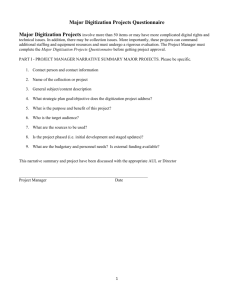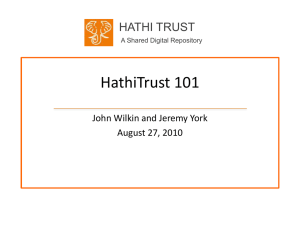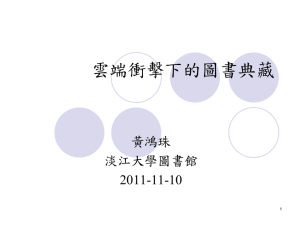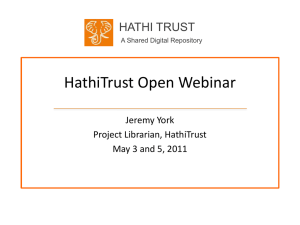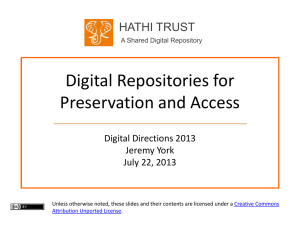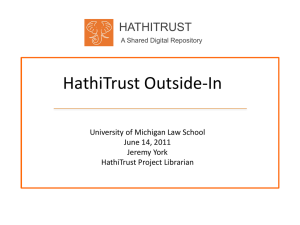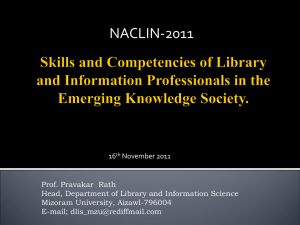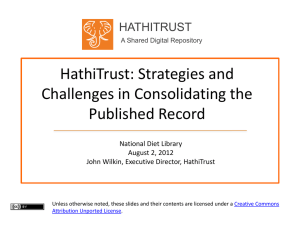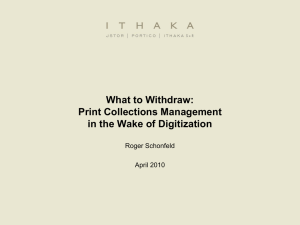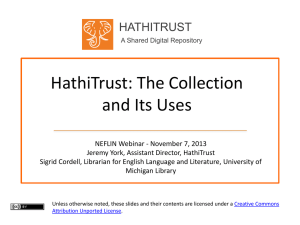What is HathiTrust and How Can It Be Used?
advertisement
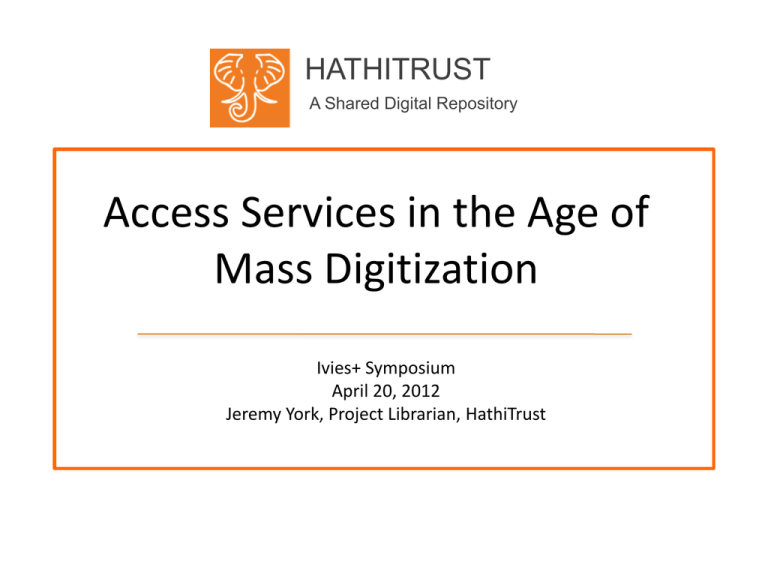
HATHITRUST A Shared Digital Repository Access Services in the Age of Mass Digitization Ivies+ Symposium April 20, 2012 Jeremy York, Project Librarian, HathiTrust • To what extent will digitization drive the use of print collections, and to what extent will it obviate the need for access to print? Use of Print • How will services such as circulation, interlibrary loan, and course reserves be changed or transformed by mass digitization of print collections? Circulation, ILL, Reserves • What new services may arise as a result of digitization? New Services • How will libraries function as physical spaces as content increasingly moves online? Physical spaces • How will user expectations of instant, online access to resources shape the future of Access Services? User expectations • To what extent will shared print repositories or cooperative collection development change what we do and how we think about Access Services Collaboration What are we trying to accomplish? What changes are occurring? Why are we digitizing? What HathiTrust is doing What implications for Access Services What has made our universities the greatest in the world has not been the transmission of knowledge…but the ability to support the creation of new knowledge and change the world through our discoveries – Jonathan Cole • John Mitchell Mason Professor of the University and Provost and Dean of Faculties, Emeritus at Columbia University This is what we are here to support …but changes Universities are: • Providing resources to others than themselves – lectures, course materials, collections • Using resources from others than themselves – Sharing resources, managing resources collaboratively – Shared print storage, UBorrow, university publication, HathiTrust • Acquiring resources in different forms and formats – Electronic vendors and platforms, the Web, datasets of different kinds • Producing resources that libraries have not traditionally handled – Digital humanities projects, datasets Other changes: • Teaching and learning – Relationship between teacher and student (mentorship) – Approaches to learning – entrepreneurial, playful, interdisciplinary, collaborative; “active learning classrooms”, students helping to design learning experience, peer critique • Data-driven infrastructure – Ben Showers of JISC: rivers of data we collect, make available for reuse; think of data rather than discovery systems; focus on use-cases for data – Managing data, facilitating reuse, becomes asset Changing roles of librarians • In data-driven environment, it is not data retrieval (a transaction), but ability to answer questions (an experience) that make libraries valuable – Stephen Abram – Designing an experience around the data • Embedded librarian – “…reposition library and information tools, resources, and expertise so that they are embedded into the teaching, learning, and research enterprises.” – David Lewis (from New Roles for New Times) • Blended librarian – Integrating instructional design and technology into librarian skill set; better serve faculty and students through deeper engagement in teaching and learning – Stephen Bell and John Shank (summary from Paul Zenke) Where does digitization fit in? • Provision of scholarly record – Access – Preservation • Recognizing digitization as a preservation reformatting method, ARL, 2004 • Hub around which to organize activities What is HathiTrust Partnership Arizona State University Baylor University Boston College Boston University California Digital Library Columbia University Cornell University Dartmouth College Duke University Emory University Florida State University Getty Research Institute Harvard University Library Indiana University Johns Hopkins University Lafayette College Library of Congress Massachusetts Institute of Technology McGill University` Michigan State University New York Public Library New York University North Carolina Central University North Carolina State University Northwestern University The Ohio State University The Pennsylvania State University Princeton University Purdue University Stanford University Texas A&M University Universidad Complutense de Madrid University of Arizona University of Calgary University of California Berkeley Davis Irvine Los Angeles Merced Riverside San Diego San Francisco Santa Barbara Santa Cruz The University of Chicago University of Connecticut University of Delaware University of Florida University of Illinois University of Illinois at Chicago The University of Iowa University of Maryland University of Miami University of Michigan University of Minnesota University of Missouri University of Nebraska-Lincoln The University of North Carolina at Chapel Hill University of Notre Dame University of Pennsylvania University of Pittsburgh University of Utah University of Virginia University of Washington University of WisconsinMadison Utah State University Washington University Yale University Library Digital Repository • Launched 2008 • Initial focus on digitized book and journal content – 10,203,436 total volumes – 5,419,737 book titles – 268,872 serial titles – 2,887,976 public domain (~28%) The Name • The meaning behind the name – Hathi (hah-tee)--Hindi for elephant – Big, strong – Never forgets, wise – Secure – Trustworthy Mission • To contribute to the common good by collecting, organizing, preserving, communicating, and sharing the record of human knowledge Collections and Collaboration • Comprehensive collection - Preservation…with Access • Shared strategies – – – – – – Copyright Collection management, development Preservation Discovery / Use Bibliographic Indeterminacy Efficient user services • Public Good Preservation and Access Preservation with Access • Cost effective preservation and access services • Preservation – TRAC-certified – Robust infrastructure – Long-term commitments on digital content facilitate planning, decision-making Preservation with Access (2) • Discovery – Bibliographic and full-text search of all materials – Extended discovery (ProQuest, EBSCO, OCLC, Ex Libris) – Mechanisms for local loading of records Preservation with Access (3) • Access and Use – Public domain and open access works – Full download of materials where possible* – Print on demand – Building Services on top of the repository • Collections and APIs – Research Center* – Lawful uses of in-copyright works* Lawful uses • Access to users who have print disabilities • Section 108 uses of materials • Access to orphan works Terms of Access • Available to students, faculty, staff of partnering institutions – On library premises or authenticated into HathiTrust • Partner libraries own a print copy – One simultaneous user per print copy owned • Users must be on U.S. soil • One page at a time download How do we facilitate uses? • Fundamental issues of – Identification – Description – Rights Copyright Automatic Rights Determination • Conducted on all works at time of ingest and when records are modified – Public domain worldwide • US works published before 1923, US federal government publications, non-US works published prior to 1872 – Public domain in the United States • Non-US works published between 1872 and 1923 Manual Rights Determination • IMLS-funded CRMS project – – – – – US-published works 1923-1963 Conformance with formalities Expanding to non-US works Double-blind review with expert review for conflicts Staff at 4 HathiTrust partner institutions (15 will take part in non-US) – As of February 2012 ~190,000 reviewed, more than 100,000 opened • Rights Holder Permissions Breakdown of HathiTrust book corpus by publication date Bibliographic Indeterminacy and the Scale of Problems and Opportunities of "Rights" in Digital Collection Building – 2/2011 Breakdown of HathiTrust book corpus by publication date Copyright status of books published pre-1923 and US works published 1923-1963 Copyright status of books published pre-1923 and US works published 1923-1963 ? Copyright status of books published pre-1923 and US works published 1923-1963 Copyright status of books published pre-1923 and US works published 1923-1963 In Print ? Collection Management, Development A global change in the library environment 60% Academic print book collection already substantially duplicated in mass digitized book corpus 50% % of Titles in Local Collection June 2010 Median duplication: 31% 40% 30% 20% June 2009 Median duplication: 19% 10% 0% 0 20 40 60 80 Rank in 2008 ARL Investment Index 100 120 Digitized Books in Shared Repositories ~3.5M titles 3,500,000 3,000,000 ~75% of mass digitized corpus is ‘backed up’ in one or more shared print repositories ~2.5M Unique Titles 2,500,000 2,000,000 1,500,000 1,000,000 500,000 0 Sep-09 Oct-09 Nov-09 Dec-09 Mass digitized books in Hathi digital repository Jan-10 Feb-10 Mar-10 Apr-10 May-10 Jun-10 Mass digitized books in shared print repositories Collection Management, Development • Overlap – More than 50% median overlap with ARL institutions; higher for small liberal arts colleges • Pricing model based on Print holdings – Requires print holdings database – Also support expansion of legal uses, efforts in deduplication – Facilitate individual and collaborative collection development and management operations • Print monographs archiving What does this mean for access services? – What happens if we succeed Do we know what effect digitization is having currently? • Columbia • University of Michigan • Issues: – What does usage mean (comparing digital accesses with requests) – Accessibility of the print and digital materials – Habits; what disciplines the volumes are from and how likely those people are to use digital; effect over time? – Usefulness of digital copies (interface, quality) Inter-library loan • Direct Lending • Shared services related to print management “…cooperative access and preservation agreements that address the ongoing need for a library print supply chain for incopyright, digitized books are an essential part of the emerging shared service environment.” - Constance Malpas, “Cloud-sourcing Research Library Collections: Managing Print in the Mass-digitized Library Environment” Digitization is changing things, but… – Back end • • • • Identification/description Copyright Third-party agreements Service agreements – Front end • User needs/preferences • To what extent will digitization drive the use of print collections, and to what extent will it obviate the need for access to print? Use of Print • How will services such as circulation, interlibrary loan, and course reserves be changed or transformed by mass digitization of print collections? Circulation, ILL, Reserves • What new services may arise as a result of digitization? New Services • How will libraries function as physical spaces as content increasingly moves online? Physical spaces • How will user expectations of instant, online access to resources shape the future of Access Services? User expectations • To what extent will shared print repositories or cooperative collection development change what we do and how we think about Access Services Collaboration Consider digital collections in relation to needs: – What does a generalized, shared collection of materials mean in a more collaborative environment? How do we… Support inquiry and creation of new knowledge Using… Increasingly interconnected collections of print materials Generalized, shared collection of digital materials Special collections Physical spaces In an environment that is… Increasingly collaborative • Institution to institution • In the classroom User-Driven • How will users use our data? • What will our role be in delivering services? • User outputs drive the data we make available for use and reuse Data-driven • Use and Reuse of materials • Bits of data • Text of these volumes on reserve for analysis • All of the place names in a group of texts • Assisting with marking up materials • How do we design an experience around the data? Support inquiry and creation of new knowledge Resources Increasingly interconnected collections of print materials Services Generalized, shared collection of digital materials Increasingly collaborative Data-driven Special collections Physical spaces Availability of resources • Determined by how we manage them; impacted by collaboration (local and global) to meet shared challenges (preservation, copyright, collection management) • Effects what is available to users User-Driven 18th Century British Shipping 1750-1800 - James Cheshire, Centre for Advanced Spatial Analysis, University College London http://spatialanalysis.co.uk/2012/03/mapped-british-shipping-1750-1800/ 18th Century Spanish Shipping 1750-1800 - James Cheshire, Centre for Advanced Spatial Analysis, University College London 18th Century Dutch Shipping 1750-1800 - James Cheshire, Centre for Advanced Spatial Analysis, University College London References 1. Association of Research Libraries. ARL 2030 Scenarios: A User’s Guide for Research Libraries, October, 2010. http://www.arl.org/rtl/plan/scenarios/usersguide/index.shtml. 2. Bell, Stephen. “‘Design Thinking’ and Higher Education.” Inside Higher Ed, March 2, 2010. http://www.insidehighered.com/views/2010/03/02/bell. 3. Bell, Stephen, and John Shank. “Blended Librarian.” Blended Librarian, n.d. http://blendedlibrarian.org/overview.html. 4. Burn-Murdoch, John. “18th Century Shipping Mapped Using 21st Century Technology.” The Guardian, April 13, 2012, sec. News. http://www.guardian.co.uk/news/datablog/2012/apr/13/shipping-routes-historymap. 5. Cheshire, James. “Mapped: British, Spanish, and Dutch Shipping 1750-1800.” Spatial Analysis, March 30, 2012. http://spatialanalysis.co.uk/2012/03/mappedbritish-shipping-1750-1800/. 6. Cole, Jonathan. “Can Graduate Education Survive As We Know It?”, University of Michigan, April 5, 2012. 7. Courant, Paul. Testimony of Dean Paul Courant at February 18, 2010 Fairness Hearing on Proposed Settlement, 2010. http://www.lib.umich.edu/michigandigitization-project/fairness-hearing-testimony-of-dean-paul-courant. 8. DeBonis, Laura. “Defending the Future of Books.” Google, February 8, 2006. http://googleblog.blogspot.com/2006/02/defending-future-of-books.html. 9. Delbanco, Andrew. “College at Risk.” The Chronicle of Higher Education, February 26, 2012, sec. The Chronicle Review. http://chronicle.com/article/College-atRisk/130893/. 10. Desantis, Nick. “Online-Education Start-Up Teams With Top-Ranked Universities to Offer Free Courses.” The Chronicle of Higher Education. The Wired Campus, April 18, 2012. http://chronicle.com/blogs/wiredcampus/online-education-start-upteams-with-top-ranked-universities-to-offer-freecourses/36048?sid=at&utm_source=at&utm_medium=en. 11. Look, Helen. “Mass Digitization: Analyzing Online Vs. Print Usage at a Large Academic Research Library”, n.d. http://www.arl.org/bm~doc/LookPoster.pdf. 12. Malpas, Constance. Cloud-sourcing Research Collections: Managing Print in the Mass-digitized Library Environment, January 2011. http://www.oclc.org/research/publications/library/2011/2011-01.pdf. 13. Showers, Ben. “Data-driven Library Infrastructure” presented at the UKSG Annual Conference, Glasgow, Scotland, March 26, 2012. http://infteam.jiscinvolve.org/wp/2012/03/29/data-driven-library-infrastructureuksg-2012-presentation/. 14. Spiro, Lisa. “Imagining the Future of the University.” The Chronicle of Higher Education. ProfHacker, March 15, 2012. http://chronicle.com/blogs/profhacker/imagining-the-future-of-theuniversity/39021?sid=at&utm_source=at&utm_medium=en. 15. Staley, David, Kara Malenfant, and Association of College and Research Libraries. Futures Thinking for Academic Librarians: Higher Education in 2025, June 2010. http://www.ala.org/acrl/sites/ala.org.acrl/files/content/issues/value/futures2025. pdf. 16. Sullivan, Brian. “Academic Library Autopsy Report”, January 2, 2011. http://chronicle.com/article/Academic-Library-Autopsy/125767/. 17. Summers, Lawrence H. “What You (Really) Need to Know.” The New York Times, January 20, 2012, sec. Education / Education Life. http://www.nytimes.com/2012/01/22/education/edlife/the-21st-centuryeducation.html. 18. Walters, Tyler, and Katherine Skinner. Digital Curation for Preservation. New Roles for New Times. Association of Research Libraries, March 2011. http://www.arl.org/bm~doc/nrnt_digital_curation17mar11.pdf. 19. Zenke, Paul. “The Emerging and Future Roles of Academic Libraries.” Education Futures, March 28, 2011. http://www.educationfutures.com/2011/03/28/theemerging-and-future-roles-of-academic-libraries/. 20. ———. “The Future of Academic Libraries: An Interview with Steven J Bell.” Education Futures, March 26, 2012. http://www.educationfutures.com/2012/03/26/the-future-of-academic-librariesan-interview-with-steven-j-bell/.
